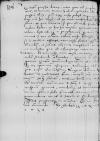Letter #2000
[Ioannes DANTISCUS] to [Bona Sforza]Heilsberg (Lidzbark Warmiński), 1538-11-26
English register:
Dantiscus is countering the slander being spread about him in connection with the tax, by sending the Queen a letter from the Council of Royal Prussia to the King [Sigismund I Jagiellon] that was sent from the Graudenz (Grudziądz) Diet. He underlines he has only one vote on the Council, and therefore he cannot be held responsible for collegial decisions. The King’s authority is extremely important to him, but in the face of the Queen’s disfavour he offers his readiness to withdraw from political life and occupy himself solely with diocesan affairs.
Manuscript sources:
Prints:
| ||||||||||||||||
Text & apparatus & commentary Plain text Text & commentary Text & apparatus
Serenissima.
Quod iterum
Ex qua revera, si pro non male factis m[alus] audire debeo, ex hoc hic consilio exauctoratus [esse] velim distractusque a prophanis (quod omnes episcopi iurant) res curare ecclesiae[3] mihi commissae. Quod si Serenissima Maiestas Vestra efficiet, rem mihi faciet apprime commodam et saluti animae meae necessariam careb[itque] ea molestia, qua ab adversariis meis toties t[ur]batur, et tum mihi omnis ansa in rebus publicis ad aulam scribendi adimetur. Qua in re non q[uam] speravi gratiam, verum indignationem et malam de me opinionem assequor. Velim hic adder[e] quanti serenissimi et clementissimi
Quem intime oro, ut Serenissimam Maiestatem Vestram quam diutissime sospitet prosperetque in omnibus.
Cui me humil[li]me commendo.
Ex
[1 ] See cf.
[2 ] There were at least two letters (of October 7, PSGPK 4, No. 4 [69], p. 216-217; cf.
[3 ] ecclesia here refers to

